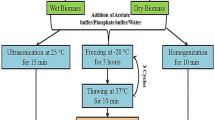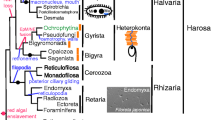Abstract
In Schizaeaceae ferns, including Anemia phyllitidis, formation of antheridia is known to be induced by exogenously applied gibberellic acid. Also present studies show that GA3 (10−5 mol·dm−3) modifies the development of gametophytes of Anemia phyllitidis. Simultaneously with formation of antheridia, they exhibit lower number of cells but only slightly lowered profile areas and lengths of prothalli. Growth in size of individual cells compensates for lowered division frequency. Cytophotometric measurements reveal no essential changes in the DNA content in vegetative cells of the control and GA3-stimulated gametophytes. It remains at haploid level and therefore it is assumed that cell cycle is blocked at G1 phase.
Application of GA3 increases the total amount of proteins. CZE (Capillary Zone Electrophoresis) separation of peptides extracted from control and GA3-treated prothalli indicates the differences in the ratio of their particular forms. In GA3-treated gametophytes the activities of acid and basic phosphatases, contents of carbohydrates (glucose, starch), chlorophyll, the number of chloroplasts and dry mass of prothalli are increased. GA3-intensified metabolism, evidenced in gametophytes of A. phyllitidis, may be interpreted as a stimulatory mechanism which influences metabolic pathways involved in forming, developing and maturing of male sex organs.
Similar content being viewed by others
References
Arnon D.I. 1949. Copper enzymes in isolated chloroplasts. Polyphenoloxidases in Beta vulgaris. Plant Physiol. 24: 1–15.
Antikainen M., Pihakaski S. 1994. Early development in RNA, protein, and sugar levels during cold stress in winter rye (Secale cereale) leaves. Ann. Bot. 74: 335–341.
Bieleski R.L. 1974. Development of an externally-located alkaline phosphatase as a response to phosphorus deficiency. In R. L. Bieleski, A. R. Ferguson and M. M. Cresswell [eds.], Mechanisms of Regulation of Plant Growth, 165–170. Bull. 12. Royal Society New Zeland, Wellington.
Bradford M.M. 1976. A rapid and sensitive method for the quantitation of microgram quantities of protein utilizing the principle of protein-dye binding. Anal. Biochem. 72: 248–254.
Bradley P.M. 1991. Plant hormones do have a role in controlling growth and development of algae. J. Phycol. 27: 317–321.
Bryant J.A., Cuming A.C. 1993. Molecular control of development. In P. J. Lea and R. C. Leegood [eds], Plant Biochemistry and Molecular Biology, 241–274. John Wiley & Sons Press.
Ferens M., Morawiecka B. 1984. Acid phosphatases of higher plants. Post. Bioch. 30: 461–475 (in Polish).
Guttenberger H. 1987. Nuclear DNA content and number of chloroplasts in Elodea canadensis after treatment with growth regulators. Phyton. 27: 47–54.
Huttly A.K., Phillips A.L. 1995. Gibberellin-regulated plant genes. Physiol. Plant. 95: 310–317.
Jusaitis M., Paleg L.G., Aspinall D. 1982. The influence of gibberellic acid and temperature on the growth rate of Avena sativa in stem segments. Plant Physiol. 70: 532–539.
Kaneko J., Kuroiwa M., Kazuhiko A., Okuda S., Kamio Y., Izaki K. 1990. Purification and properties of acid phosphatases from axes and cotyledons of germinating soybean. Agric. Biol. Chem. 54: 745–751.
Katsu N., Kamisaka S. 1981. Effect of gibberellic acid and metabolic inhibitors of DNA and RNA synthesis on hypocotyl elongation and cell wall loosening in dark-grown lettuce seedlings. Plant Cell Physiol. 22: 327–331.
Kaźmierczak A., Maszewski J. 1997. Inhibition of GA3-induced antheridiogenesis in Anemia phyllitidis by peptidic extracts from male sex organs of Chara. Acta Physiol. Plant. 19: 269–276.
Kwiatkowska M. 1995. Effect of symplasmic isolation and antigibberellin treatment on morphogenesis in Chara. Folia Histochem. Cytobiol. 33: 133–137.
Maszewski J. 1991. Endopolyploidization patterns in non-generative cells in mono- and dioecious Chara spp. (Characeae) with different DNA C-values. Plant System. Evol. 177: 39–52.
Miller H. J. 1968. Fern gametophytes as experimental material. Bot. Review 34: 361–440.
Mohamed Y., Capesius I. 1980. Effect of gibberellic acid and FdUrd on quantity and quality of DNA during elongation growth in Pisum sativum. Zentralbl. Pflanzenphysiol. 98: 15–23.
Mohr H. 1956. Die Abhängigkeit des Protonemawachstums und der Protonemapolarität bei Farnen von Licht. Planta 47: 127–158.
Näf U. 1966. On dark-germination and antheridium formation in Anemia phyllitidis. Physiol. Plant. 19: 1079–1088.
Näf U., Nakanishi K., Endo M. 1975. On the physiology and chemistry of fern antheridiogens. Bot. Review 41: 315–359.
Pitt D., Gaplin M. 1971. Increase in ribonuclease activity following mechanical damage to leaf and tuber tissue of Solanum tuberosum L. Planta (Berl.) 101: 317–332.
Raghavan V. 1977. Gibberellic acid-induced germination of spores of Anemia phyllitidis: Authoradiographic study of the timing and regulation of nucleic acid and protein synthesis in relation to cell morphogenesis. J. Cell Sci. 23: 85–100.
Raghavan V. 1993. Differential expression of nuclear and plastid genes induced by red light and gibberellic acid during germination of spores of the fern Anemia phyllitidis. Am. J. Bot. 80: 385–390.
Rappaport L. 1980. Plant growth hormones: internal control points. Bot. Gaz. 141: 125–130.
Schraudolf H. 1962. Die Wirkung von Phytohormonen auf Keimung und Entwicklung von Farnprothallien I. Auslösung der Antheridienbildung und Dunkelkeimung bei Schizaeaceen durch Gibberellinsäure. Biol. Zentralbl. 81: 731–740.
Schraudolf H. 1964. Relative activity of gibberellins in antheridium induction in Anemia phyllitidis. Nature 201: 98–99.
Schraudolf H. 1966. Die Wirkung von Phytohormonen auf Keimung und Entwicklung von Farnprothallien II. Analyse der Wachselbeziehung zwischen Gibberellinkoncentration, Antheridienbildung und Physiologichem Alter der Prothalliumzellen von Anemia phyllitidis. Planta 68: 335–352.
Takeno K., Furuya M. 1977. Inhibitory effect of gibberellins on archegonial differentiation in Lygodium japonicum. Physiol. Plant. 39: 135–138.
Vasil I. K. 1973. Morphogenetic, histochemical and ultrastructural effects of plant growth substances in vitro. Biochem. Pflanzen Physiol. 164: 58–71.
Author information
Authors and Affiliations
Rights and permissions
About this article
Cite this article
Kaźmierczak, A. Studies on morphology and metabolism of prothalli during GA3-induced formation of antheridia in Anemia phyllitidis . Acta Physiol Plant 20, 277–283 (1998). https://doi.org/10.1007/s11738-998-0059-4
Received:
Accepted:
Published:
Issue Date:
DOI: https://doi.org/10.1007/s11738-998-0059-4




